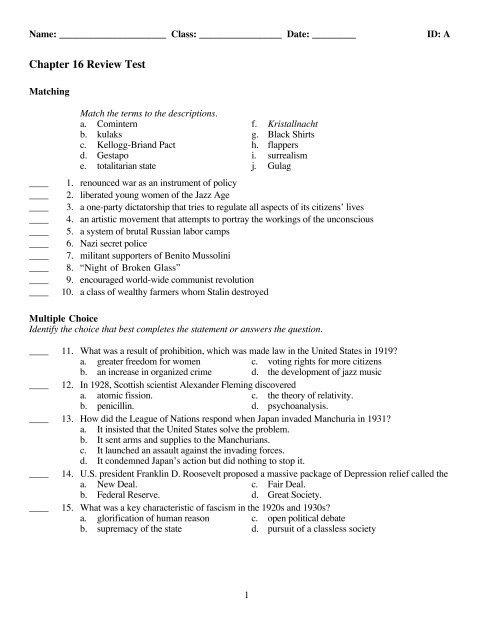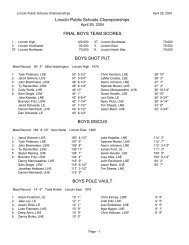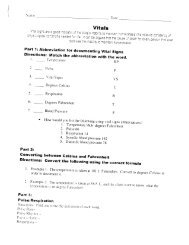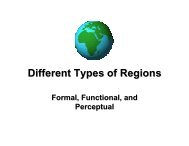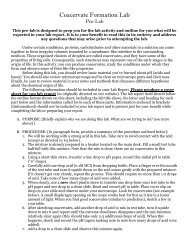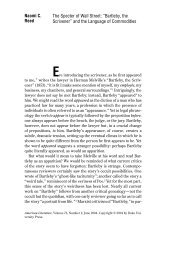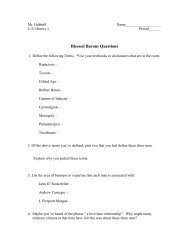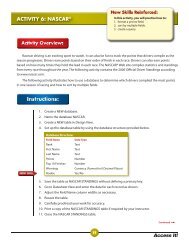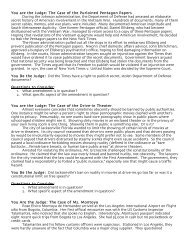Chapter 16 Review Test
Chapter 16 Review Test
Chapter 16 Review Test
You also want an ePaper? Increase the reach of your titles
YUMPU automatically turns print PDFs into web optimized ePapers that Google loves.
Name: ______________________ Class: _________________ Date: _________ ID: A<br />
<strong>Chapter</strong> <strong>16</strong> <strong>Review</strong> <strong>Test</strong><br />
Matching<br />
Match the terms to the descriptions.<br />
a. Comintern f. Kristallnacht<br />
b. kulaks g. Black Shirts<br />
c. Kellogg-Briand Pact h. flappers<br />
d. Gestapo i. surrealism<br />
e. totalitarian state j. Gulag<br />
____ 1. renounced war as an instrument of policy<br />
____ 2. liberated young women of the Jazz Age<br />
____ 3. a one-party dictatorship that tries to regulate all aspects of its citizens’ lives<br />
____ 4. an artistic movement that attempts to portray the workings of the unconscious<br />
____ 5. a system of brutal Russian labor camps<br />
____ 6. Nazi secret police<br />
____ 7. militant supporters of Benito Mussolini<br />
____ 8. “Night of Broken Glass”<br />
____ 9. encouraged world-wide communist revolution<br />
____ 10. a class of wealthy farmers whom Stalin destroyed<br />
Multiple Choice<br />
Identify the choice that best completes the statement or answers the question.<br />
____ 11. What was a result of prohibition, which was made law in the United States in 1919?<br />
a. greater freedom for women c. voting rights for more citizens<br />
b. an increase in organized crime d. the development of jazz music<br />
____ 12. In 1928, Scottish scientist Alexander Fleming discovered<br />
a. atomic fission. c. the theory of relativity.<br />
b. penicillin. d. psychoanalysis.<br />
____ 13. How did the League of Nations respond when Japan invaded Manchuria in 1931?<br />
a. It insisted that the United States solve the problem.<br />
b. It sent arms and supplies to the Manchurians.<br />
c. It launched an assault against the invading forces.<br />
d. It condemned Japan’s action but did nothing to stop it.<br />
____ 14. U.S. president Franklin D. Roosevelt proposed a massive package of Depression relief called the<br />
a. New Deal. c. Fair Deal.<br />
b. Federal Reserve. d. Great Society.<br />
____ 15. What was a key characteristic of fascism in the 1920s and 1930s?<br />
a. glorification of human reason c. open political debate<br />
b. supremacy of the state d. pursuit of a classless society<br />
1
Name: ______________________ ID: A<br />
____ <strong>16</strong>. On Stalin’s collectives,<br />
a. individual peasants could own small plots of land.<br />
b. agricultural output skyrocketed in the 1930s.<br />
c. the government provided tractors, fertilizers, and seed.<br />
d. peasants set all prices and controlled access to farm supplies.<br />
____ 17. Stalin attempted to make the cultural life of the Soviet Union more Russian by promoting a policy of<br />
a. russification. c. tsarism.<br />
b. surrealism. d. capitalism.<br />
____ 18. France occupied Germany’s coal-rich Ruhr Valley in 1923<br />
a. to protest the policies of Adolf Hitler.<br />
b. because the French wanted to acquire more land.<br />
c. to force striking German miners back to work.<br />
d. because Germany had fallen behind in reparations.<br />
____ 19. What 1924 agreement reduced German reparations and provided U.S. loans to Germany?<br />
a. Dawes Plan c. Locarno treaties<br />
b. Versailles treaty d. Kellogg-Briand Pact<br />
____ 20. In 1935, the Nazis passed the Nuremberg Laws which<br />
a. combined all Protestant sects into a single state church.<br />
b. deprived Jews of German citizenship.<br />
c. required all young Germans to join the Hitler Youth.<br />
d. established the Third Reich under Hitler.<br />
2
Name: ______________________ ID: A<br />
Short Answer<br />
21. Recognize Propaganda The Nazis used this poster during the 1932 Reichstag election. It reads<br />
“Work and Food.” What is the message conveyed in this poster? Why do you think the Nazis<br />
viewed this as one of their most effective posters?<br />
22. Make Comparisons Compare and contrast the ways Britain, France, and the United States dealt with<br />
the problems created by the Great Depression.<br />
23. Recognize Ideologies What were the main characteristics of fascist governments of the 1930s? Why<br />
did fascists dislike democratic ideals?<br />
24. Make Generalizations The fascists could not have come to power in Italy or Germany without<br />
some popular support. Why did many people prefer fascism over a constitutional government?<br />
25. Summarize How did the Soviet Union’s command economy work? Was it successful?<br />
3
<strong>Chapter</strong> <strong>16</strong> <strong>Review</strong> <strong>Test</strong><br />
Answer Section<br />
MATCHING<br />
1<br />
ID: A<br />
1. ANS: C PTS: 1 DIF: Easy REF: p. 893<br />
OBJ: 28.2.1 Summarize the domestic and foreign policy issues Europe faced after World War I.<br />
STA: 12.1.7 | 12.2.10 TOP: disarmament<br />
2. ANS: H PTS: 1 DIF: Easy REF: p. 885<br />
OBJ: 28.1.1 Analyze how Western society changed after World War I.<br />
STA: 12.2.10 TOP: popular culture<br />
3. ANS: E PTS: 1 DIF: Easy REF: p. 901<br />
OBJ: 28.3.3 Understand the values and goals of fascist ideology.<br />
STA: 12.1.8 | 12.2.10 TOP: totalitarianism<br />
4. ANS: I PTS: 1 DIF: Easy REF: p. 889<br />
OBJ: 28.1.2 Describe the literary and artistic trends that emerged in the 1920s.<br />
STA: 12.1.6 | 12.2.10 TOP: modern art<br />
5. ANS: J PTS: 1 DIF: Easy REF: p. 906<br />
OBJ: 28.4.2 Explain how Stalin tried to control how people thought in the Soviet Union.<br />
STA: 12.1.8 | 12.2.10 TOP: Stalinism<br />
6. ANS: D PTS: 1 DIF: Easy REF: p. 915<br />
OBJ: 28.5.2 Describe the Nazi party's political, social, economic, and cultural policies.<br />
STA: 12.1.8 | 12.2.10 TOP: Nazism<br />
7. ANS: G PTS: 1 DIF: Easy REF: p. 899<br />
OBJ: 28.3.1 Describe how conditions in Italy favored the rise of Mussolini.<br />
STA: 12.1.8 | 12.2.10 TOP: fascism<br />
8. ANS: F PTS: 1 DIF: Easy REF: p. 9<strong>16</strong><br />
OBJ: 28.5.2 Describe the Nazi party's political, social, economic, and cultural policies.<br />
STA: 12.1.8 | 12.2.10 TOP: Nazism<br />
9. ANS: A PTS: 1 DIF: Easy REF: p. 911<br />
OBJ: 28.4.4 Outline Soviet foreign policy under Stalin. STA: 12.1.8 | 12.2.10<br />
TOP: Soviet Union<br />
10. ANS: B PTS: 1 DIF: Easy REF: p. 905<br />
OBJ: 28.4.1 Describe the effects of Stalin's five-year plans. STA: 12.1.8 | 12.2.10<br />
TOP: Stalinism<br />
MULTIPLE CHOICE<br />
11. ANS: B PTS: 1 DIF: Moderate REF: p. 885<br />
OBJ: 28.1.1 Analyze how Western society changed after World War I.<br />
STA: 12.2.10 TOP: Prohibition<br />
12. ANS: B PTS: 1 DIF: Moderate REF: p. 888<br />
OBJ: 28.1.3 List several advances in modern scientific thought. STA: 12.1.6 | 12.2.10<br />
TOP: science
2<br />
ID: A<br />
13. ANS: D PTS: 1 DIF: Difficult REF: p. 893<br />
OBJ: 28.2.1 Summarize the domestic and foreign policy issues Europe faced after World War I.<br />
STA: 12.1.7 | 12.2.10 TOP: League of Nations<br />
14. ANS: A PTS: 1 DIF: Easy REF: p. 897<br />
OBJ: 28.2.4 Analyze how the Great Depression began and spread and how Britain, France, and the<br />
United States tried to address it. TOP: Great Depression<br />
15. ANS: B PTS: 1 DIF: Moderate REF: pp. 901-902<br />
OBJ: 28.3.3 Understand the values and goals of fascist ideology.<br />
STA: 12.1.8 | 12.2.10 TOP: fascism<br />
<strong>16</strong>. ANS: C PTS: 1 DIF: Moderate REF: p. 905<br />
OBJ: 28.4.1 Describe the effects of Stalin's five-year plans. STA: 12.1.8 | 12.2.10<br />
TOP: Stalinism<br />
17. ANS: A PTS: 1 DIF: Easy REF: p. 908<br />
OBJ: 28.4.2 Explain how Stalin tried to control how people thought in the Soviet Union.<br />
STA: 12.1.8 | 12.2.10 TOP: Stalinism<br />
18. ANS: D PTS: 1 DIF: Moderate REF: p. 913<br />
OBJ: 28.5.1 Analyze the problems faced by the Weimar Republic.<br />
STA: 12.1.8 | 12.2.10 TOP: Weimar Republic<br />
19. ANS: A PTS: 1 DIF: Moderate REF: p. 913<br />
OBJ: 28.5.1 Analyze the problems faced by the Weimar Republic.<br />
STA: 12.1.8 | 12.2.10 TOP: Weimar Republic<br />
20. ANS: B PTS: 1 DIF: Moderate REF: p. 915<br />
OBJ: 28.5.2 Describe the Nazi party's political, social, economic, and cultural policies.<br />
STA: 12.1.8 | 12.2.10 TOP: Nazism<br />
SHORT ANSWER<br />
21. ANS:<br />
Possible response: The arms holding the work implements from above represent the Nazis. The<br />
outstretched hands from below represent the German people. The message in this poster states that<br />
the Nazis can provide the German people with both work and food. The image suggests a fatherly<br />
relationship between the Nazis and everyday Germans. During the Great Depression, this was<br />
probably a powerful message. It works well as propaganda because the message is brief and is<br />
delivered in a simple slogan. The Nazis likely viewed this poster as one of their most effective<br />
because of its directness and simplicity. It presents a message that is so clear it cannot be<br />
misunderstood.<br />
PTS: 1 DIF: Moderate REF: pp. 915-9<strong>16</strong><br />
OBJ: 28.5.2 Describe the Nazi party's political, social, economic, and cultural policies.<br />
STA: 12.1.8 | 12.2.10 TOP: propaganda
3<br />
ID: A<br />
22. ANS:<br />
Possible response: In Britain, political leaders provided some unemployment benefits to citizens.<br />
Otherwise, they did not act decisively. By 1931, one in four workers in Britain was unemployed. The<br />
lack of strong leadership also hurt relief efforts in France. In that country, leftist parties behind the<br />
socialist government passed some social legislation. However, this was unable to satisfy radicals.<br />
France lacked the strong leadership needed to make change.<br />
During the early part of the Depression, the efforts of the U.S. government were also limited. This<br />
was influenced by Hoover’s belief in “small government.” This changed when Franklin D.<br />
Roosevelt became president in 1932. Roosevelt’s New Deal legislation was a massive package of<br />
economic and social programs. These programs greatly expanded the federal government. Though<br />
the New Deal eased suffering, it did not end the Great Depression.<br />
PTS: 1 DIF: Moderate REF: pp. 896-897<br />
OBJ: 28.2.3 Describe how the Great Depression began and spread and how Britain, France, and the<br />
United States tried to address it. STA: 12.1.8 | 12.2.10<br />
TOP: Great Depression<br />
23. ANS:<br />
Possible response: Fascism in the 1930s was largely rooted in extreme nationalism. It glorified<br />
emotion, action, violence, discipline, and blind loyalty to the state. Fascism was generally militaristic.<br />
Fascist countries often pursued a policy of aggressive foreign expansion. Fascism also strongly<br />
opposed socialism and communism. It supported a society with rigidly defined classes. Fascists<br />
disliked democratic ideals such as equality and liberty. They thought that democracy puts individual<br />
or class interests above national goals. Democracy, they argued, often leads to corruption.<br />
PTS: 1 DIF: Moderate REF: pp. 901, 902<br />
OBJ: 28.3.3 Understand the values and goals of fascist ideology.<br />
STA: 12.1.8 | 12.2.10 TOP: fascism<br />
24. ANS:<br />
Possible response: In the years after World War I, Germany and Italy experienced social, economic,<br />
and political turmoil. In Italy, many peasants seized land. Industrial workers went on strike or took<br />
control of factories. Trade declined and taxes rose. In Germany, economic problems caused inflation<br />
to spiral out of control. The German mark became almost worthless. Millions of Germans went<br />
broke, and unemployment was very high. Many feared that the communists would come to power.<br />
People became angry at the existing governments since they were powerless to solve these problems.<br />
Citizens were desperate for a solution. Fascists promised to restore social order, solve economic<br />
problems, and provide a new sense of national pride. This was a powerful message. As evidence of<br />
this, even people in foreign democracies praised the governments of Italy and Germany before they<br />
began their campaigns of aggression.<br />
PTS: 1 DIF: Difficult REF: pp. 898-902, 912-917<br />
OBJ: 28.3.3 Understand the values and goals of fascist ideology.<br />
STA: 12.1.8 | 12.2.10 TOP: fascism
4<br />
ID: A<br />
25. ANS:<br />
Possible response: In the Soviet Union’s command economy, government officials made all the basic<br />
economic decisions. (In a capitalist system, the free market determines what products are produced<br />
and the quantity in which they are produced.) The central planning in the Soviet Union was often<br />
inefficient. It caused both shortages and surpluses. The Soviet economy turned out low-quality goods<br />
since there was no competition. (In a capitalist economy, competition is the reason why businesses<br />
produce high-quality products.) Overall, this system was not successful since it ensured chronic<br />
shortages, poor products, and a low standard of living for the Soviet people.<br />
PTS: 1 DIF: Moderate REF: pp. 904-910<br />
OBJ: 28.4.1 Describe the effects of Stalin's five-year plans. STA: 12.1.8 | 12.2.10<br />
TOP: Stalinism


